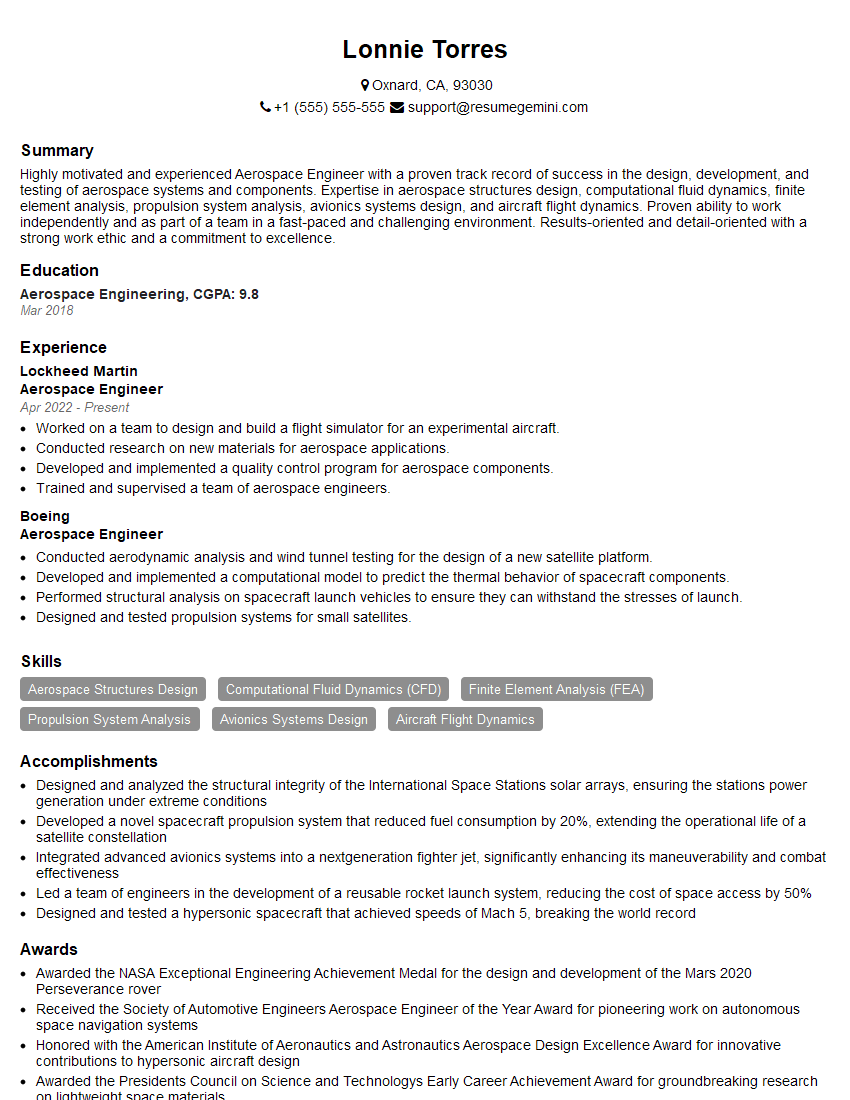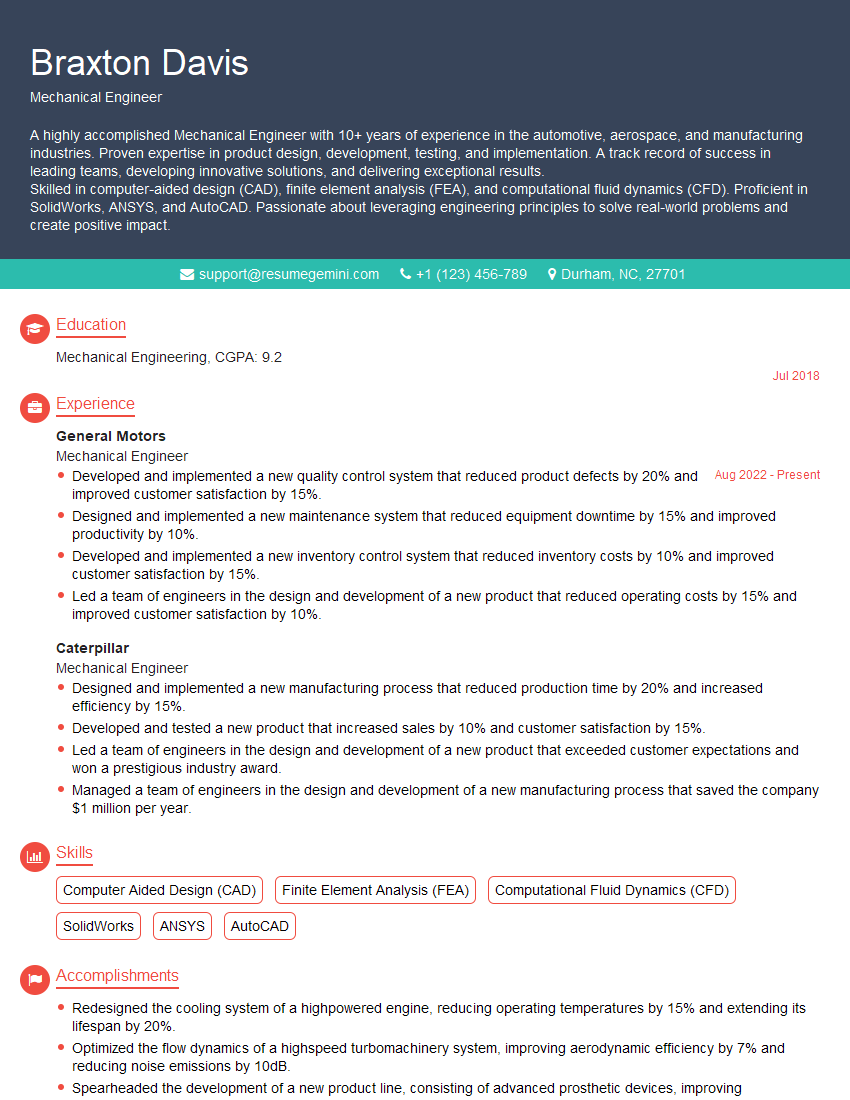The thought of an interview can be nerve-wracking, but the right preparation can make all the difference. Explore this comprehensive guide to Linear Analysis interview questions and gain the confidence you need to showcase your abilities and secure the role.
Questions Asked in Linear Analysis Interview
Q 1. Define a linear transformation. Give an example.
A linear transformation, also known as a linear map, is a function between two vector spaces that preserves the operations of vector addition and scalar multiplication. In simpler terms, it’s a way to transform vectors from one space to another in a way that respects the linear structure of those spaces. This means that if you take two vectors, add them, and then transform the result, it’s the same as transforming each vector individually and then adding the transformed vectors. Similarly, multiplying a vector by a scalar before transformation gives the same result as transforming the vector and then multiplying by the scalar.
Example: Consider the transformation T: ℝ2 → ℝ2 defined by T(x, y) = (2x + y, x – y). Let’s check linearity. If we take vectors u = (1, 2) and v = (3, 1), then u + v = (4, 3). T(u) = (4, -1), T(v) = (7, 2), and T(u + v) = (11, 1). Notice that T(u) + T(v) = (11, 1) = T(u + v), satisfying the addition property. Similarly, the scalar multiplication property holds. This transformation is a linear transformation because it maintains the relationships between vectors under addition and scalar multiplication.
Q 2. Explain the concept of linear independence.
Linear independence refers to a set of vectors where none of the vectors can be expressed as a linear combination of the others. In other words, you can’t write one vector in the set as a sum of multiples of the other vectors in the set. If you can express one vector as a linear combination of the others, the set is linearly dependent.
Imagine this: Think of vectors as directions. If vectors are linearly independent, they point in fundamentally different directions. If they’re linearly dependent, at least one vector is redundant; it’s pointing in a direction that can be achieved by combining other vectors.
Example: The vectors (1, 0) and (0, 1) in ℝ2 are linearly independent. You cannot write one as a scalar multiple of the other. However, the vectors (1, 0), (0, 1), and (2, 1) are linearly dependent because (2, 1) = 2(1, 0) + 1(0, 1).
Q 3. What is a basis for a vector space?
A basis for a vector space is a set of linearly independent vectors that span the entire space. ‘Spanning the space’ means that every vector in the space can be written as a linear combination of the vectors in the basis. The basis provides a minimal set of vectors needed to represent any vector in the space.
Analogy: Think of a coordinate system. In 2D space, the x and y axes form a basis. Any point in the plane can be uniquely represented by its x and y coordinates, which are the scalar multiples of the basis vectors (1,0) and (0,1).
Example: In ℝ3, the standard basis is {(1, 0, 0), (0, 1, 0), (0, 0, 1)}. Any vector (x, y, z) can be expressed as x(1, 0, 0) + y(0, 1, 0) + z(0, 0, 1).
Q 4. How do you find the eigenvalues and eigenvectors of a matrix?
Eigenvalues and eigenvectors are fundamental concepts in linear algebra. An eigenvector of a square matrix A is a non-zero vector v such that when A is applied to v, the result is a scalar multiple of v. That scalar multiple is the eigenvalue. Mathematically, this is represented as Av = λv, where λ is the eigenvalue.
Finding them: To find eigenvalues, we solve the characteristic equation det(A – λI) = 0, where I is the identity matrix. The solutions λ are the eigenvalues. Once we have the eigenvalues, we substitute each λ back into (A – λI)v = 0 and solve for v to find the corresponding eigenvectors.
Example: Let A = [[2, 1], [1, 2]]. The characteristic equation is (2 – λ)2 – 1 = 0, which gives eigenvalues λ1 = 3 and λ2 = 1. Substituting λ1 = 3, we get [[-1, 1], [1, -1]]v = 0, leading to eigenvector v1 = [1, 1]. Similarly for λ2 = 1, we get eigenvector v2 = [-1, 1].
Q 5. Explain the significance of eigenvalues and eigenvectors.
Eigenvalues and eigenvectors reveal crucial information about a linear transformation represented by a matrix. Eigenvectors represent the directions that remain unchanged (only scaled) by the transformation, and eigenvalues indicate the scaling factor along those directions. They are crucial in understanding the behavior of the transformation.
Significance: Eigenvalues and eigenvectors have numerous applications, including stability analysis in dynamical systems (determining if a system converges or diverges), principal component analysis (dimensionality reduction in data analysis), and solving differential equations.
Real-world application example: In image compression, the eigenvectors of the covariance matrix of image pixels (principal components) can be used to represent the image with fewer data points, resulting in compression while retaining most of the image information.
Q 6. What is the rank of a matrix? How is it calculated?
The rank of a matrix is the dimension of the vector space generated (or spanned) by its columns (or rows). It essentially represents the number of linearly independent columns (or rows) in the matrix.
Calculating Rank: There are several ways to calculate the rank. One common method is Gaussian elimination (row reduction) to find the row echelon form of the matrix. The rank is then equal to the number of non-zero rows in the row echelon form. Other methods involve using the singular value decomposition or determinant calculations for smaller matrices.
Example: Consider the matrix A = [[1, 2, 3], [4, 5, 6], [7, 8, 9]]. After row reduction, we find that the matrix has only two linearly independent rows, hence its rank is 2.
Q 7. Describe the null space and column space of a matrix.
The null space (or kernel) of a matrix A is the set of all vectors x such that Ax = 0. It represents the subspace of vectors that are mapped to the zero vector by the linear transformation represented by A. The dimension of the null space is the nullity of the matrix.
The column space (or range) of a matrix A is the vector space spanned by its column vectors. It represents the set of all possible vectors that can be obtained by applying the linear transformation A to any vector in its domain. The dimension of the column space is the rank of the matrix.
Relationship: The rank-nullity theorem states that the rank of a matrix plus its nullity equals the number of columns in the matrix. This reflects the relationship between the information preserved (rank) and information lost (nullity) in a linear transformation.
Q 8. What is a singular matrix? How do you determine if a matrix is singular?
A singular matrix is a square matrix that does not have a matrix inverse. Think of it like this: a regular number has a reciprocal (e.g., the reciprocal of 2 is 1/2). A singular matrix doesn’t have a mathematical equivalent of a reciprocal. This lack of an inverse has significant consequences in linear algebra.
We determine if a matrix is singular by checking its determinant. If the determinant of a square matrix is zero, the matrix is singular. If the determinant is non-zero, the matrix is non-singular (invertible).
Example:
Consider the matrix A = [[1, 2], [2, 4]]. The determinant of A is (1*4) – (2*2) = 0. Therefore, matrix A is singular. It’s impossible to find another matrix that, when multiplied by A, results in the identity matrix.
Practical Application: In many real-world applications, such as solving systems of linear equations, a singular matrix indicates that the system either has no solution or infinitely many solutions. This might represent a problem with the model or the data, suggesting a need for re-evaluation or adjustment.
Q 9. Explain the concept of matrix diagonalization.
Matrix diagonalization is the process of transforming a square matrix into a diagonal matrix, which is a matrix with non-zero elements only on its main diagonal. This transformation is achieved using a similarity transformation. Imagine it like rotating a shape to align its axes with the coordinate system—the shape remains the same, just its orientation changes.
Specifically, if we have a square matrix A, we can diagonalize it if we can find an invertible matrix P and a diagonal matrix D such that A = PDP-1. The columns of P are the eigenvectors of A, and the diagonal elements of D are the corresponding eigenvalues.
Example: If A has linearly independent eigenvectors, it is diagonalizable. The process involves finding the eigenvalues and eigenvectors of A, and then constructing P and D accordingly.
Practical Application: Diagonalization simplifies many matrix operations. For instance, calculating powers of a matrix becomes much easier: An = PDnP-1. This is valuable in various fields, including computer graphics (matrix transformations), and systems of differential equations.
Q 10. How do you solve a system of linear equations using matrix methods?
Solving systems of linear equations using matrix methods involves representing the system as a matrix equation. A system of m linear equations in n unknowns can be written in the form Ax = b, where A is an m x n coefficient matrix, x is an n x 1 column vector of unknowns, and b is an m x 1 column vector of constants.
The solution, if it exists, can be found by various methods: If A is a square, invertible matrix, then x = A-1b. Alternatively, methods like Gaussian elimination or LU decomposition can be used even if A is not invertible or not square.
Example: Consider the system:
x + 2y = 3
3x - y = 1
This can be written as: [[1, 2], [3, -1]] [[x], [y]] = [[3], [1]]. We can solve for x and y using matrix inversion (if A is invertible) or other methods.
Q 11. What are different methods for solving systems of linear equations?
Several methods exist for solving systems of linear equations. The choice depends on the size and properties of the matrix, as well as computational efficiency considerations.
- Gaussian Elimination: A systematic method that uses elementary row operations to transform the augmented matrix into row echelon form or reduced row echelon form. This method is relatively simple and widely applicable.
- LU Decomposition: Factorizes the coefficient matrix
Ainto a lower triangular matrixLand an upper triangular matrixU(A = LU). SolvingAx = bthen becomes solving two simpler triangular systems:Ly = bandUx = y. - Matrix Inversion: If the coefficient matrix is square and invertible, the solution is directly obtained as
x = A-1b. However, this is computationally expensive for large matrices. - Iterative Methods (e.g., Jacobi, Gauss-Seidel): These methods generate a sequence of approximate solutions that converge to the exact solution. They are particularly useful for large, sparse matrices.
Real-world Application: In engineering, these methods are crucial for structural analysis, circuit simulation, and other areas involving solving large systems of equations.
Q 12. Describe Gaussian elimination and its applications.
Gaussian elimination is a systematic procedure for solving systems of linear equations. It involves performing elementary row operations on the augmented matrix (the coefficient matrix augmented with the constant vector) to transform it into row echelon form or reduced row echelon form.
Elementary Row Operations:
- Swapping two rows
- Multiplying a row by a non-zero scalar
- Adding a multiple of one row to another row
The goal is to obtain a triangular form, making it straightforward to solve for the unknowns using back substitution. Reduced row echelon form simplifies the process further by directly yielding the solution.
Example: Let’s revisit the system from question 3. The augmented matrix is [[1, 2, 3], [3, -1, 1]]. Through row operations, we can reduce this to row echelon form, and then solve for x and y.
Applications: Gaussian elimination is fundamental in linear algebra and has applications in various fields, including solving systems of equations in engineering, computer graphics (finding intersections), and optimization problems.
Q 13. What is LU decomposition and how is it used to solve linear systems?
LU decomposition is a matrix factorization method where a square matrix A is decomposed into a lower triangular matrix L and an upper triangular matrix U such that A = LU. This decomposition is extremely useful for solving systems of linear equations efficiently.
Solving Linear Systems: Once we have the LU decomposition of A, solving Ax = b becomes a two-step process:
- Solve
Ly = bfory(forward substitution, simple due to triangular form). - Solve
Ux = yforx(backward substitution, also simple due to triangular form).
This approach is computationally more efficient than Gaussian elimination, especially for multiple systems with the same coefficient matrix (only the LU decomposition needs to be done once).
Example: Finding the LU decomposition of a matrix involves a series of row operations similar to Gaussian elimination. Then, the two triangular systems are solved sequentially.
Applications: LU decomposition is extensively used in numerical analysis for solving large systems of equations efficiently, particularly in scientific computing and engineering applications, like finite element analysis.
Q 14. Explain the concept of least squares approximation.
Least squares approximation is a method used to find the best fit line (or hyperplane in higher dimensions) for a set of data points when no exact solution exists. This is common when dealing with noisy or overdetermined systems (more equations than unknowns).
The method minimizes the sum of the squares of the differences between the observed values and the values predicted by the model. In essence, it finds the line that is closest to all the data points simultaneously.
Mathematical Formulation: For a system Ax = b where there’s no exact solution, the least squares solution x̂ minimizes the error vector ||Ax - b||22, where ||.||2 is the Euclidean norm (the magnitude of the vector). The solution is given by x̂ = (ATA)-1ATb, provided that ATA is invertible.
Example: Fitting a straight line to a scatter plot of data points. The least squares method provides the equation of the line that best approximates the relationship between the variables.
Applications: This technique finds applications across diverse fields such as statistics (regression analysis), machine learning (linear regression), and signal processing. It’s fundamental for dealing with real-world data that are often imperfect and noisy.
Q 15. How do you use linear algebra in machine learning?
Linear algebra is the backbone of many machine learning algorithms. At its core, machine learning involves finding patterns in data, and this data is often represented as vectors and matrices. Linear algebra provides the tools to manipulate and analyze this data efficiently.
Data Representation: Datasets are often represented as matrices, where rows represent data points and columns represent features.
Dimensionality Reduction: Techniques like Principal Component Analysis (PCA) use singular value decomposition (SVD), a core linear algebra concept, to reduce the dimensionality of data while preserving important information. Imagine trying to analyze the movement of a robot arm with many joints; PCA can help you identify the principal directions of movement, simplifying the analysis.
Model Training: Many machine learning models, such as linear regression and support vector machines (SVMs), are based on solving systems of linear equations or optimization problems that heavily rely on linear algebra. For instance, finding the best-fitting line in linear regression involves solving a system of equations using matrix operations.
Deep Learning: Even in deep learning, linear algebra is crucial. Neural networks consist of layers of matrices performing linear transformations followed by non-linear activation functions. Backpropagation, the algorithm used to train neural networks, relies heavily on matrix calculus.
In essence, linear algebra provides the mathematical language and tools necessary to efficiently represent, manipulate, and analyze the vast amounts of data used in machine learning.
Career Expert Tips:
- Ace those interviews! Prepare effectively by reviewing the Top 50 Most Common Interview Questions on ResumeGemini.
- Navigate your job search with confidence! Explore a wide range of Career Tips on ResumeGemini. Learn about common challenges and recommendations to overcome them.
- Craft the perfect resume! Master the Art of Resume Writing with ResumeGemini’s guide. Showcase your unique qualifications and achievements effectively.
- Don’t miss out on holiday savings! Build your dream resume with ResumeGemini’s ATS optimized templates.
Q 16. What is a linear program? Give an example.
A linear program (LP) is an optimization problem where the objective function and the constraints are all linear. This means that all variables are raised to the power of one and there are no products or divisions of variables. The goal is to either maximize or minimize the objective function while satisfying all the constraints.
Example: Imagine a furniture manufacturer producing chairs and tables. Each chair requires 2 hours of labor and 1 unit of wood, while each table requires 4 hours of labor and 2 units of wood. The manufacturer has 16 hours of labor and 8 units of wood available. The profit from each chair is $3 and from each table is $5. The manufacturer wants to maximize profit. This can be formulated as a linear program:
Maximize: 3x + 5y (where x is the number of chairs and y is the number of tables)
Subject to:
2x + 4y ≤ 16(labor constraint)x + 2y ≤ 8(wood constraint)x ≥ 0, y ≥ 0(non-negativity constraints)
Here, the objective function (profit) and constraints (labor and wood) are all linear. Solving this LP will determine the optimal number of chairs and tables to produce to maximize profit.
Q 17. Describe the simplex method for solving linear programs.
The simplex method is an iterative algorithm used to solve linear programs. It works by moving from one feasible solution (a solution that satisfies all constraints) to another, progressively improving the value of the objective function until an optimal solution is found. Imagine walking along a mountain range trying to find the highest peak; the simplex method is like strategically choosing your path, always moving uphill.
The method involves:
Initialization: Starting at a feasible solution (often the origin).
Iteration: Moving along an edge of the feasible region (the set of all feasible solutions) in a direction that improves the objective function. This involves finding a variable to enter the basis (become a basic variable) and a variable to leave the basis.
Optimality Check: At each iteration, the algorithm checks if the current solution is optimal. If not, it continues iterating.
Termination: The algorithm terminates when no further improvement in the objective function is possible, indicating that an optimal solution has been found.
The simplex method is efficient for most linear programs, but in worst-case scenarios, it can exhibit exponential runtime. However, in practice, it is a very powerful and widely-used tool for solving LPs.
Q 18. Explain the concept of duality in linear programming.
Duality in linear programming is a powerful concept that provides a different perspective on the same optimization problem. Every linear program (the primal problem) has an associated dual problem, which is another linear program. The primal and dual problems are intimately connected, and their optimal solutions reveal important insights.
Consider the primal problem of minimizing costs, the dual problem often represents maximizing profits under resource constraints. The optimal solutions of both problems provide the same optimal value (although the variable values might differ). This allows for verification and provides economic interpretations.
Key aspects of duality:
Weak duality: The objective function value of the dual problem is always less than or equal to the objective function value of the primal problem (for minimization problems).
Strong duality: If both the primal and dual problems have feasible solutions, then their optimal values are equal.
Complementary slackness: This provides a relationship between the optimal primal and dual solutions, offering additional insights.
Duality is not just a theoretical concept; it has practical applications in sensitivity analysis and finding bounds on the optimal solution.
Q 19. What are the applications of linear programming in real-world problems?
Linear programming has a wide range of applications in diverse fields. Its ability to optimize resource allocation makes it invaluable in many real-world problems.
Operations Research: Optimizing production schedules, transportation routes, inventory management, and portfolio optimization.
Finance: Portfolio optimization (maximizing returns while minimizing risk), capital budgeting.
Engineering: Design optimization (minimizing weight or cost while meeting performance requirements), resource allocation in network design.
Agriculture: Optimizing crop yields, fertilizer usage, and water allocation.
Logistics: Optimizing transportation networks, delivery routes, warehouse location.
Essentially, any problem that can be formulated as maximizing or minimizing a linear objective function subject to linear constraints can benefit from linear programming techniques. The key is to properly define the objective function, decision variables, and constraints based on the specific problem context.
Q 20. What is a vector norm and why is it important?
A vector norm is a function that assigns a non-negative length or magnitude to a vector. It’s a way of quantifying the ‘size’ of a vector, much like the absolute value quantifies the size of a scalar. Vector norms are crucial in many areas, including machine learning, optimization, and numerical analysis.
The importance of vector norms stems from their use in:
Measuring distances: Norms define distances between vectors, forming the basis for many distance-based algorithms.
Regularization: In machine learning, norms are used for regularization to prevent overfitting and improve model generalization.
Convergence analysis: Norms are essential for analyzing the convergence of iterative algorithms.
Stability analysis: Norms help to assess the sensitivity of solutions to small perturbations in the input data.
Choosing the appropriate norm depends on the specific application and the nature of the data.
Q 21. Explain different types of vector norms (L1, L2, etc.)
Several common vector norms exist, each with its own properties and applications:
L1 Norm (Manhattan distance): Defined as the sum of the absolute values of the vector components.
||x||₁ = Σ|xᵢ|. It is robust to outliers since large values do not disproportionately affect the norm. Think of navigating a city grid; the L1 norm represents the total distance travelled along the streets (no diagonal cuts).L2 Norm (Euclidean distance): Defined as the square root of the sum of the squares of the vector components.
||x||₂ = √(Σxᵢ²). This is the familiar Euclidean distance, representing the straight-line distance between points. It’s the most commonly used norm in many applications.L∞ Norm (Maximum norm): Defined as the maximum absolute value of the vector components.
||x||∞ = max(|xᵢ|). It represents the largest component of the vector. Imagine finding the tallest building in a city; the L∞ norm represents the height of the tallest building.Lp Norm: A generalization of the above norms, defined as
||x||ₚ = (Σ|xᵢ|ᵖ)^(1/p). L1 and L2 norms are special cases of the Lp norm for p=1 and p=2, respectively.
The choice of norm often depends on the specific application and desired properties. For instance, L1 regularization encourages sparsity (many zero components) in the solution, while L2 regularization promotes smaller values across all components.
Q 22. What is a matrix norm and why is it important?
A matrix norm is essentially a way to measure the ‘size’ or ‘magnitude’ of a matrix. Think of it like the absolute value for numbers, but for matrices. It assigns a non-negative real number to a matrix, quantifying its influence or impact. This is crucial because it allows us to define concepts like convergence of matrix sequences and stability of numerical algorithms.
The importance of matrix norms stems from their use in various applications. For example, in numerical linear algebra, norms help analyze the error propagation during computations. In machine learning, matrix norms are used in regularization techniques to prevent overfitting. In control theory, they’re used to assess the stability of systems.
Q 23. Describe different types of matrix norms.
Several types of matrix norms exist, each with its own properties and applications. Some common ones include:
- Frobenius Norm: This is the most straightforward norm, analogous to the Euclidean norm for vectors. It’s calculated as the square root of the sum of the squares of all the matrix elements.
||A||_F = sqrt(Σ_i Σ_j |a_ij|^2). It’s computationally simple and often used in optimization problems. - Induced Norms (Operator Norms): These norms are defined based on the vector norms they induce. For example, the
l1induced norm (||A||_1) is the maximum absolute column sum, while thel∞induced norm (||A||_∞) is the maximum absolute row sum. Thel2induced norm (||A||_2) is the largest singular value of the matrix, closely related to the matrix’s eigenvalues. They are essential for analysing the effect of a linear transformation. - Spectral Norm: This is equivalent to the
l2induced norm and represents the largest singular value of the matrix. It measures the maximum amount a matrix can stretch a vector. It is particularly important in analysing matrix decompositions and stability.
The choice of norm depends heavily on the specific application. For instance, the Frobenius norm is computationally efficient, while induced norms provide insights into the matrix’s effect on vectors.
Q 24. Explain the concept of orthogonality.
Orthogonality is a geometric concept that describes two vectors (or more generally, subspaces) being perpendicular to each other. In a two-dimensional space, it’s easy to visualize: two lines are orthogonal if they intersect at a right angle (90 degrees). Mathematically, this translates to their dot product being zero.
In higher dimensions, the concept remains the same, but the visualization becomes more abstract. Two vectors u and v are orthogonal if their inner product (or dot product) is zero: u · v = 0. This means they are independent and don’t share any directional components. Orthogonality is a cornerstone in many linear algebra techniques, such as orthogonalization and least squares approximation.
Q 25. What is the Gram-Schmidt process and how does it work?
The Gram-Schmidt process is an algorithm that takes a set of linearly independent vectors and produces an orthonormal set – meaning the vectors are orthogonal and have unit length. This is extremely useful because orthonormal bases simplify many calculations.
The process works iteratively. Let’s say we have a set of linearly independent vectors {v1, v2, …, vn}. The algorithm generates an orthonormal set {u1, u2, …, un} as follows:
- u1 = v1 / ||v1|| (Normalize the first vector)
- w2 = v2 – (v2 · u1)u1 (Project v2 onto u1 and subtract the projection)
- u2 = w2 / ||w2|| (Normalize the resulting vector)
- Repeat the process for subsequent vectors: wi = vi – Σj=1i-1 (vi · uj)uj, and ui = wi / ||wi||
The resulting set {u1, u2, …, un} forms an orthonormal basis for the subspace spanned by the original vectors. This process finds widespread application in areas like creating orthonormal bases for function spaces and solving least squares problems.
Q 26. How do you find the projection of a vector onto a subspace?
Projecting a vector onto a subspace means finding the closest point in that subspace to the given vector. Imagine shining a light from the vector onto the subspace; the projection is where the light hits the subspace. This is fundamental in many applications, such as data compression and signal processing.
To find the projection of vector v onto subspace W spanned by an orthonormal basis {u1, u2, …, um}, we use the formula:
projW(v) = Σi=1m (v · ui)ui
If the basis is not orthonormal, you’d need to use the Gram-Schmidt process first to orthonormalize it before applying this formula. The result is the vector in W that is closest to v in terms of Euclidean distance.
Q 27. Explain the concept of inner product.
The inner product is a generalization of the dot product to more abstract vector spaces. It’s a function that takes two vectors as input and returns a scalar value. This scalar value captures information about the relationship between the two vectors – specifically, their relative orientation and magnitudes. The dot product in Euclidean space is a specific type of inner product.
The key properties of an inner product are:
- Linearity in the first argument:
⟨au + bv, w⟩ = a⟨u, w⟩ + b⟨v, w⟩ - Conjugate symmetry:
⟨u, v⟩ = ⟨v, u⟩*(where * denotes complex conjugate) - Positive definiteness:
⟨u, u⟩ ≥ 0, and⟨u, u⟩ = 0if and only ifu = 0
Inner products enable us to define concepts like orthogonality, length (norm), and angles in abstract vector spaces, making them essential for many areas of mathematics and physics.
Q 28. What is the spectral theorem and its implications?
The spectral theorem is a cornerstone result in linear algebra. It states that a symmetric (or Hermitian in the complex case) matrix can be diagonalized by an orthogonal (or unitary) matrix. In simpler terms: we can find a set of orthonormal eigenvectors that span the entire vector space, and the eigenvalues will be the diagonal entries of the diagonalized matrix.
This has profound implications:
- Eigenvalue Decomposition: The theorem allows us to decompose a symmetric matrix into the product of three matrices:
A = UΛUT(where U is an orthogonal matrix of eigenvectors, and Λ is a diagonal matrix of eigenvalues). - Simplification of Computations: The diagonalized form simplifies many matrix calculations, like raising a matrix to a power (Ak = UΛkUT) or solving linear systems.
- Applications in Physics and Engineering: It underpins many techniques in physics (quantum mechanics, vibrations) and engineering (structural analysis, signal processing), where symmetric matrices often represent physical systems.
The spectral theorem provides a powerful tool for analysing and manipulating symmetric matrices, making it invaluable across various scientific and engineering disciplines.
Key Topics to Learn for Linear Analysis Interview
- Vector Spaces and Linear Transformations: Understanding the fundamental concepts of vector spaces, their properties, and the actions of linear transformations is crucial. Consider exploring different types of vector spaces and how linear transformations affect them.
- Practical Application: Image processing and compression techniques heavily rely on linear algebra and transformations. Understanding this connection can provide valuable context and demonstrate your practical knowledge.
- Linear Independence and Bases: Mastering the concepts of linear independence, spanning sets, and bases is fundamental. Be prepared to discuss these concepts in various contexts and apply them to problem-solving.
- Inner Product Spaces and Orthogonality: A thorough understanding of inner product spaces, orthogonality, and orthogonal projections is essential. Explore the geometric interpretations of these concepts.
- Practical Application: Machine learning algorithms, especially those involving dimensionality reduction, leverage inner product spaces and orthogonality. Being familiar with these applications is highly advantageous.
- Eigenvalues and Eigenvectors: This is a core concept in linear algebra. Understand how to calculate eigenvalues and eigenvectors, and be prepared to discuss their significance in various applications.
- Practical Application: Eigenvalues and eigenvectors are critical in understanding the stability and dynamics of systems, with applications in areas like control systems and network analysis.
- Linear Operators and Their Properties: Explore properties of linear operators, such as boundedness, invertibility, and their spectral properties. Consider how these relate to other concepts like eigenvalues.
- Normed and Banach Spaces: Grasp the concepts of norms, completeness, and the properties of Banach spaces. Understanding these forms the foundation for more advanced topics.
- Problem-Solving Approach: Develop a systematic approach to solving problems involving linear transformations, matrices, and vector spaces. Practice proving theorems and solving theoretical problems to enhance your analytical skills.
Next Steps
Mastering Linear Analysis significantly enhances your prospects in numerous fields, including data science, machine learning, and engineering. A strong foundation in these concepts demonstrates analytical prowess and problem-solving abilities highly valued by employers. To maximize your chances, create an ATS-friendly resume that showcases your skills and experience effectively. ResumeGemini is a trusted resource to help you build a professional and impactful resume. Examples of resumes tailored to Linear Analysis positions are available to guide you.
Explore more articles
Users Rating of Our Blogs
Share Your Experience
We value your feedback! Please rate our content and share your thoughts (optional).
What Readers Say About Our Blog
These apartments are so amazing, posting them online would break the algorithm.
https://bit.ly/Lovely2BedsApartmentHudsonYards
Reach out at [email protected] and let’s get started!
Take a look at this stunning 2-bedroom apartment perfectly situated NYC’s coveted Hudson Yards!
https://bit.ly/Lovely2BedsApartmentHudsonYards
Live Rent Free!
https://bit.ly/LiveRentFREE
Interesting Article, I liked the depth of knowledge you’ve shared.
Helpful, thanks for sharing.
Hi, I represent a social media marketing agency and liked your blog
Hi, I represent an SEO company that specialises in getting you AI citations and higher rankings on Google. I’d like to offer you a 100% free SEO audit for your website. Would you be interested?


















